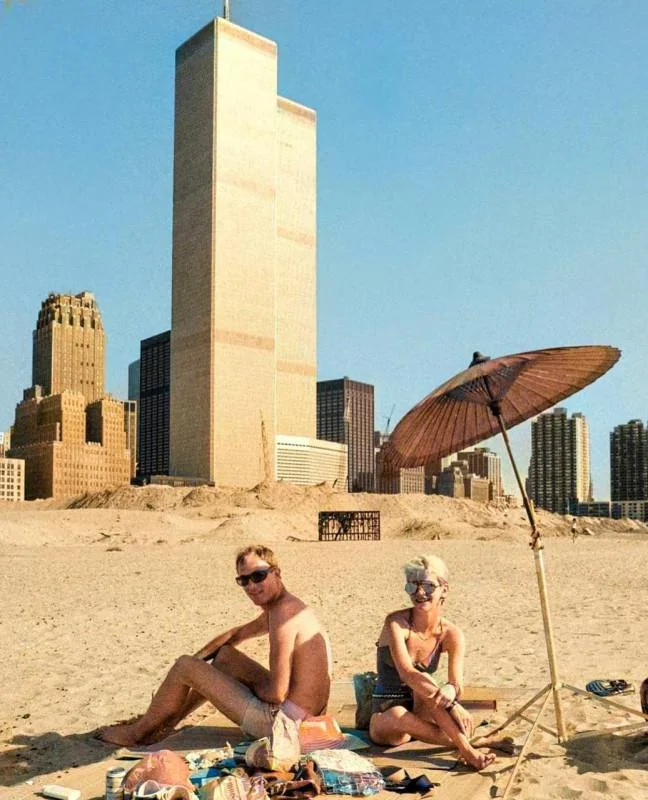
Recently, I saw an amazing picture pop up on my phone – it was a stunning view of the Twin Towers in Manhattan, with a beautiful beach right in front of them.
People were relaxing on the sand, making it look like they were in a tropical paradise. But is this really possible?
New York City’s forgotten beach oasis
If you take a walk by the water near Battery Park today, where the Twin Towers used to be, it’s hard to picture that there used to be a beach there.
Now, the place is filled with shiny buildings and busy streets, and you can hear the city all around you. The water gently splashes against a new walkway, giving you a nice view of the Statue of Liberty far away.

Getty Images
People used to sunbathe here, enjoying the sun’s warmth and the shade from the World Trade Center. It was a hidden beach paradise with its own sandy shore, where the busy city felt far away, and the waters of Manhattan’s harbor welcomed those looking for a peaceful escape.
This sandy spot wasn’t planned at all; it just happened because of the construction delays of the World Trade Center in the mid-1970s.
Wasn’t meant for public use
As the huge base for the Twin Towers was being built, workers dug up dirt from the nearby area, which created a temporary beach by the water.
Even though it wasn’t meant for the public, people from Manhattan quickly started using it as their own little getaway. Sunbathers enjoyed the warm sunshine, volleyball games sprang up in the sand, and readers found their quiet spots by the water, all while being shaded by the tall World Trade Center.
What used to be a construction site turned into a hidden treasure, and the sandy area became known as Battery Park Beach.
Surprisingly, some people still remember what it was like to relax on that beach, including Suellen Epstein. She grew up in the nearby Tribeca neighborhood and is the girl in the picture below, enjoying the summer sun in 1977.
In an interview with Tribeca Citizen, Suellen talked about her memories of the beach, mentioning that the sand wasn’t the soft, fine type you’d find on a tropical beach. Instead, it was a bit rough, and of course, it never had the ocean waves washing over it.
But hey, it did the trick.

Suellen told Tribeca Citizen that going to the Hamptons was too expensive for them. She mentioned, “We enjoyed our sunny Sundays at the beach, as long as it wasn’t raining. It was the best place to chill and read the Sunday Times.”
In the photo above, Suellen and her boyfriend were having a rare calm moment together. On that day, the beach seemed like it was just for them.
“It felt like we were getting away from the city, almost like being in the countryside of Manhattan,” Suellen recalled.
Hosting the largest anti-nuclear rally in history
The huge area of landfill that turned into the beach wasn’t just a nice place to relax; it also became an important spot for social change. A famous black-and-white picture taken on September 23, 1979, shows a sandy area that changed into the center of a huge anti-nuclear protest.
Thousands of people gathered on the sand, enjoying the sunny weather, live music, and a lot of debate that brought 200,000 people to the edge of Manhattan for what would be the biggest anti-nuclear and pro-solar rally ever.

Getty Images
The day was unforgettable not only because of the huge crowd but also because the beach was filled with famous people who supported the cause. Artists like Pete Seeger and Jackson Browne sang, and Jane Fonda gave an inspiring speech.
This rally was like a new beginning for the national protest movement, which had mostly disappeared after the Vietnam War ended in 1975.
This time, the focus was on nuclear power, and the event was sparked by the nuclear accident in Harrisburg that happened earlier that year.
Striking installations
Battery Park Beach, also known as Tribeca Beach, was a lively place filled with creativity and performances. Many small dance groups were doing well, and artists found it possible to live and work in the city. During this time, a public arts group called Creative Time got funding to bring art to the beach, featuring an impressive installation by local environmental artist Mary Miss.
In 1980, the beach hosted an event called Art on the Beach, which gave young sculptor Nancy Rubins a chance to showcase her talent in this unique spot. At just 27 years old, she was amazed by the size of the area and the engineering involved. She created a piece made from discarded materials like lampshades, hoses, and small appliances, which she collected from various Goodwill stores.
Her artwork ended up being a towering 45-foot structure made of junk.
“It was very humbling to work at that site. I was young, and it was so huge,” she shared with The New York Times.
A gigantic wheat field
One amazing installation at the site was Wheatfield – A Confrontation by artist Agnes Denes. This artwork made a bold statement about the tall buildings around it. It featured two acres of wheat growing just a few blocks away from Wall Street and the World Trade Center, right across from the Statue of Liberty.

Denes and her team dedicated a whole month to planting wheat, with her putting in 16-hour days to make everything work out. The project aimed to show the financial leaders of the country how urgent environmental issues really are.
“Creating a wheat field on land valued at $4.5 billion was a striking contradiction. The wheat field stood for many things; it symbolized food, energy, trade, and economics. At the same time, it highlighted problems like mismanagement, waste, hunger, and environmental issues,” Denes explains on her website.
When you look at the photos from this project, they are almost as breathtaking as the beach itself, don’t you agree?
The truth behind the Manhattan beach photo
The imaginative vibe that inspired David Vanden-Eynden and Chris Galori to head to the beach is also what caught my attention about this story. They are the ones shown in the picture below, which was taken by Fred Conrad, who used to work as a photographer for The New York Times. This photo was snapped back in 1977.
David, who works as an environmental graphic designer, shared his memories in an interview with The New York Times in 2019. He said, “There was nothing there yet, and there were spectacular views of the towers and across the river.” He also mentioned that some parts of the landfill were blocked off from the public, but not everything was restricted.
The creative spirit that brought David Vanden-Eynden and Chris Galori to the beach is what drew me to this story in the first place — they’re the ones featured in the image below, taken by Fred Conrad, a former photographer for The New York Times.
The photo was captured in 1977.
David, an environmental graphic designer, recalled the scene in an interview with The New York Times in 2019:
There wasn’t anything there at the moment, but the views of the towers and the river were amazing. He also mentioned that even though some parts of the landfill were blocked off for safety, not every area was off-limits to the public.
The eerie truth behind the pictures
So, what’s the story behind this almost unbelievable place?
According to The New York Times, everything began to shift in 1983 when around 3,000 people settled in Battery Park City. Today, it seems more like a calm office district rather than a bustling city neighborhood.
By the year 2000, a lot of the old landfill had been transformed into buildings and parks.
But in 2001, an event occurred that changed our perspective on this area. It’s tough to forget the sad memories of September 11th when we see those images of people enjoying the sunshine.

On the Beach, Manhattan, 1977
Today, we understand what they could not: the heartbreaking destiny of the World Trade Center, a destiny that would change New York City’s skyline forever.
These photos now have a haunting and somber feel to them. One person, thinking about the images, said, “Wow! This picture shows everything: life, death, youth, age, calmness, and hope.”
It’s tough not to feel the heaviness of that thought. These sunbathers, enjoying their day, had no idea of the tragedy that would happen years later.
“There’s so much to say,” another person added. “But I’ll just watch and weep.”
As we gaze at these famous images, we’re reminded of a chilling reality: time keeps moving forward, and with it, everything shifts — often in ways we never expect.
Did you enjoy this story? Feel free to share it with your friends, preferably by hitting the share button on Facebook.





